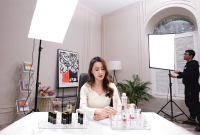With the possible TikTok Ban coming up soon (it’s set for January 19), the Creator Economy has changed a lot. Brands were hoping that a lot of people would come back to Meta-owned platforms like Instagram.
Rednote, an unknown app, is now the top app on the App Store, five days before the ban.
What is Rednote?
Miranda Qu and Charlwin Mao started RedNote, which is also known as Xiaohongshu (which means “Little Red Book”), in China in 2013. Reports say that 70% of the people who use the platform were born after 1990, and over 70% of them are women. (Wiki)
Tencent and Alibaba, two Chinese digital giants, have invested in the site, which has about 300 million active users. But in the last 48 hours, TikTok Creators have taken it by storm because they want to establish a new area that isn’t owned by Meta/Zuckerberg.
This is clearly a protest vote and not just a search for a new app.
Data Issues
The US government has said that data privacy issues are why TikTok is banned, but not much has been said about Rednote’s data privacy and a lot of people are signing up. Since RedNote is still new to the US market, people are constantly learning about how it handles data.
A lot of the important features and terminology are only available in Mandarin for now, so it’s unclear that many US customers know exactly what Data practice they’re joining up for.
It is also not clear what its Content Policy is right now, such as what images, subjects, and terms are okay and which ones will be monitored or lead to user bans. Brands that want to enter this new market may lose money and damage their reputation as they try to understand the cultural differences.
What does this have to do with Brand Content or Content Studios?
This rapid and unexpected change is only another step in the growth of the Creator Community, and Brands may need to respond to it and learn from it. This is a new area for Western Brands, and there are risks involved. Will the creator economy stay ahead of brand content, and how will this change the way content is made in 2025?
In-House Studios Had Trouble Making TikTok Videos
The TikTok app put a lot of emphasis on quick, easy-to-digest material. Authenticity and humor were two of the most important factors, and brands often have a hard time finding their identity in these areas. Solo creators had a lot more followers than brand accounts, with a few notable exceptions.
Behind-the-scenes and storytelling content were more valuable than finished products, but in-house studios didn’t plan for or take advantage of this.
It was okay for Instagram that planned brand content took a long time to come out (72 hours is slow by social media standards), but it was a big reason why brands failed on TikTok.
A lot of brands missed out on the TikTok content explosion because they were sluggish to react and couldn’t take advantage of it by making relevant content that got people involved and developed community.
Instagram versus TikTok
Instagram is a safe space for many firms. It’s renowned, easy to navigate around, and easier to market with sponsored posts. Influencers also tend to get a little more consistency on the site. (Any social media manager would be pleased to talk about what went wrong with the app.)
TikTok was even harder to regulate than Instagram because the design gave the User the authority. Its algorithm put engagement ahead of Instagram’s paid posts.
Users know that the Instagram feed is flawed and that the experience isn’t great. The algorithm doesn’t work, and it’s not clear if it can be changed by 2025.
Why does this matter when making studio content?
As individual inventors developed whole communities The US and EU fashion models were dramatically changed by specialized micro trends in 2024. material creators could make a lot of interesting and useful material for little money, which most in-house Brand Studios couldn’t do.
Brands became more and more disconnected from their customers. I suggest following Joanna Williams if you want to learn more about this.
Is Rednote going to be the next TikTok?
It is too early to say for sure, but the past week has shown that governments will have a hard time using laws to get the purchasing power and attention of a younger generation of producers.
At the beginning of 2025, the creative community will also be particularly focused on not buying Meta-owned products. Fashion brands should keep this in mind when making their content strategy.
Do brands need to change their content strategies for Rednote? Not very likely right now, but they will need to learn how to deal with an audience that is very engaged and cautious.
What might that mean for Content Creation in the next three months? What app will really take TikTok’s place, and how should businesses get ready for the next generation of content platforms?




